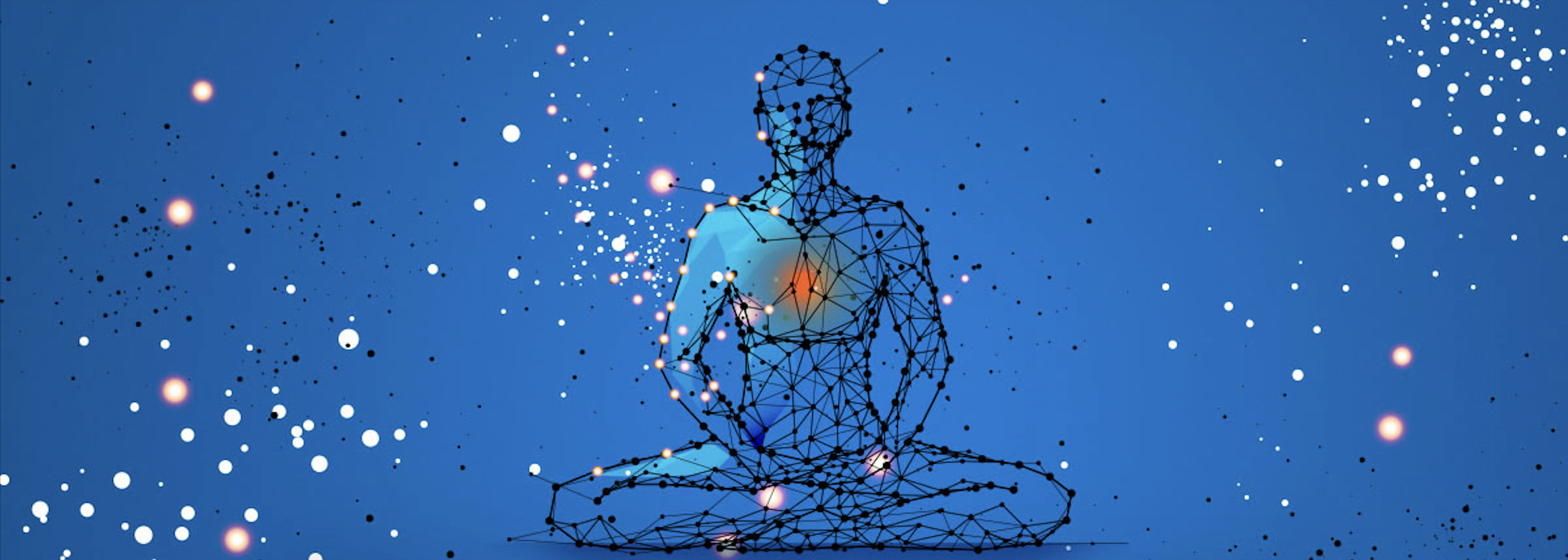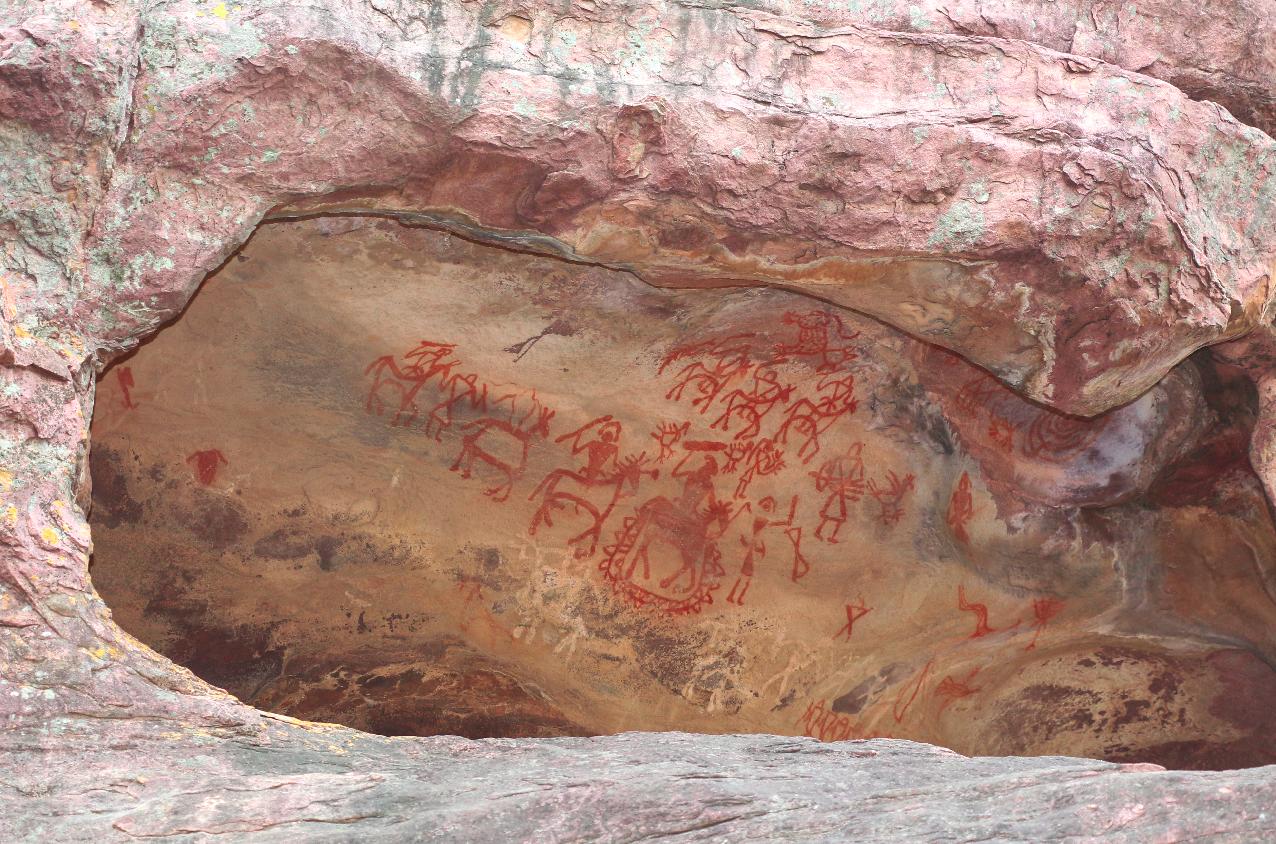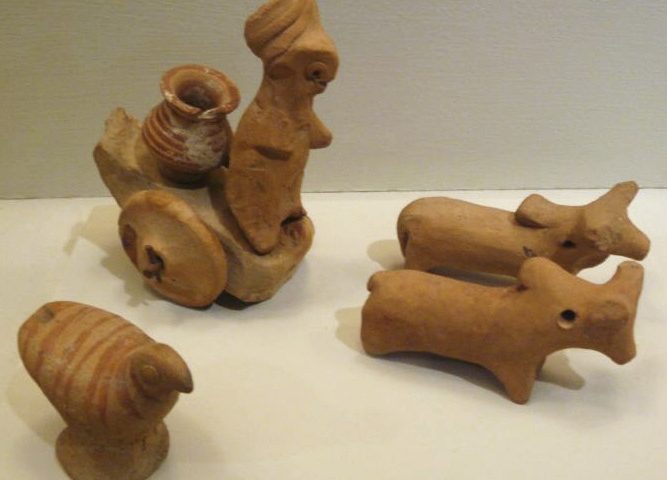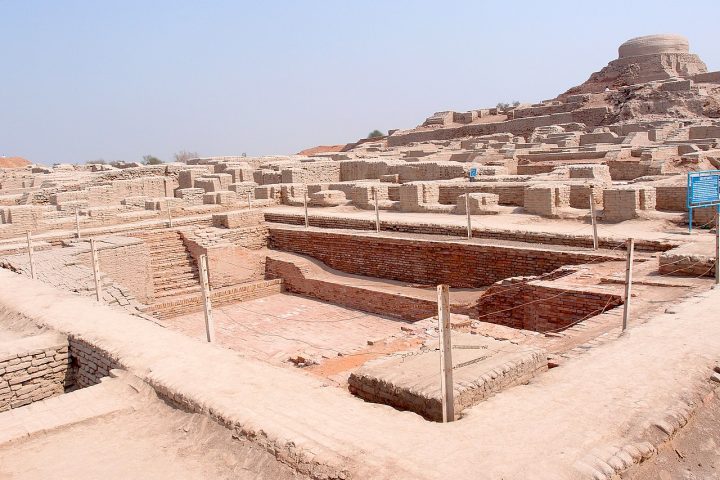Bhimbetka rock shelter is situated in the Indian state of Madhya Pradesh, nearby the state capital ‘Bhopal’. The Bhimbetka rock shelters (a UNESCO World Heritage Site) have beautiful rock arts and cave paintings that belong to the Paleolithic and Mesolithic time periods.
You can also listen to this post here:
Ancient Rock Arts
Let’s see some of the other sites where ancient rock art (artwork where different paintings and designs were made on the wall of rock caves, cliffs, ceilings, and grounds) were found:-
- The Sulawesi warty pig painting in Indonesia is believed to be 45, 500 years old and is said to be the oldest form of rock art found to date.
- Second, on the list is Altamira cave which dates back 35,600 years back. These paintings were founded in Northern Spain around the 19th century. Paintings comprise the figures of the bison, horses, and handprints.
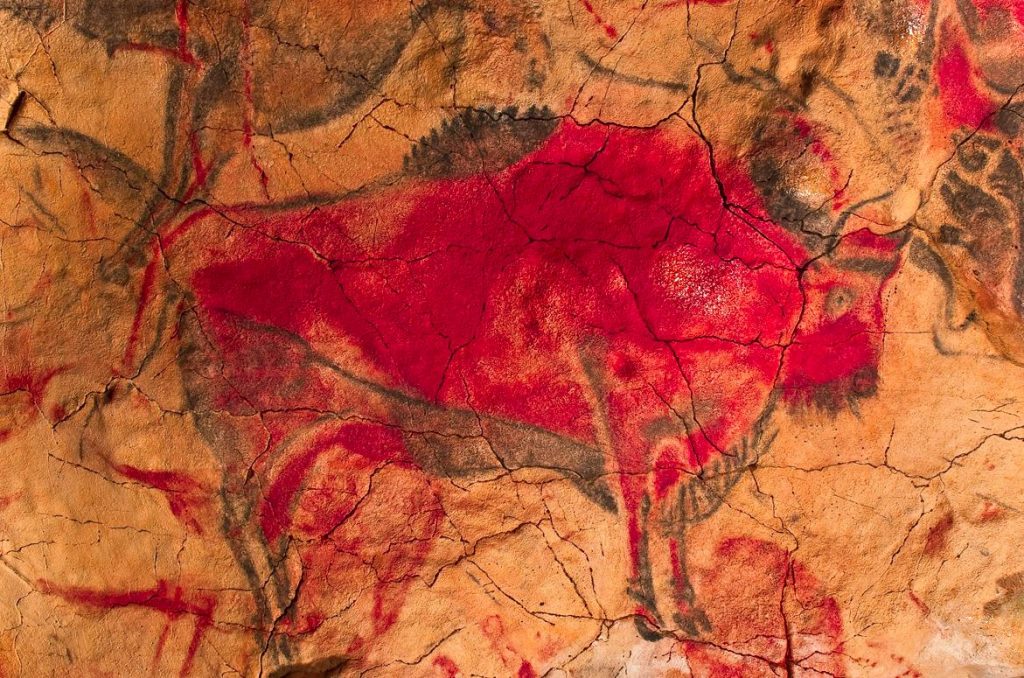
Museo de Altamira y D. Rodríguez, CC BY-SA 3.0 https://creativecommons.org/licenses/by-sa/3.0, via Wikimedia Commons
- Serra Da Capivara is situated in the Northeastern region of Brazil in the national park of the same name. These paintings are believed to be 25,000 years old. Scenes of hunting, rituals, and figures of trees, and animals were found here.
- France’s most beautiful rock art – The Lascaux caves are around 17,000 years old. It comprises various paintings but the most famous one is the bull painting which has figures of trees, and horses as well. The interesting thing is the size of the bull which is around 17 inches in length.
Now, let’s move on to the next section of Bhimbetka rock shelters.
Do you know Art has always influenced Humanity? Check out this link to learn more.
Bhimbetka Rock Shelters
Bhimbetka Rock Shelters are situated in the foothill of the Vindhyan Mountains at a distance of 45 km Southeast of Bhopal. Bhimbetka was included in the UNESCO World Heritage Sites in 2003 because of the uniqueness of this place. The art form found here is ages-old and dates back to different time periods. Some of the cave paintings belong to the Paleolithic time period whereas others belong to the Mesolithic time period.
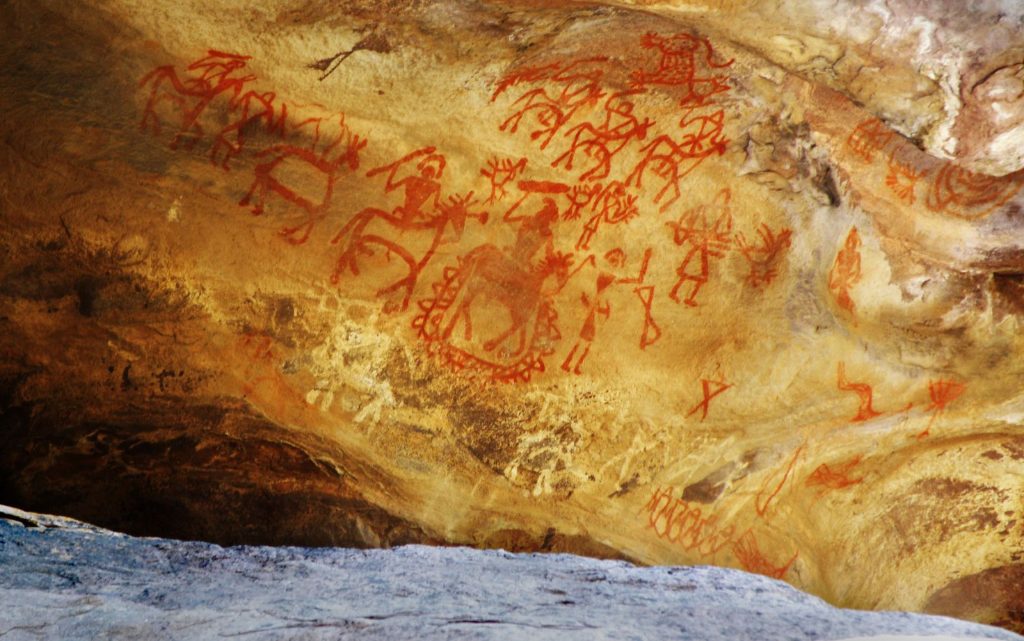
By Raveesh Vyas – originally posted to Flickr as भीमबैटिका/Bhimbetka Cave Paintings, CC BY-SA 2.0, https://commons.wikimedia.org/w/index.php?curid=7756171
The Bhimbetka rock art was discovered in 1957. The complex holds around 700 shelters which is the largest repository of prehistoric art in India. These sandstone rocks have undergone massive formations over the course of time.
The foothills of Vindhyan hill alone have around 243 shelters and 133 rock paintings.
Apart from the cave paintings, archaeologists have recovered various artifacts inside the caves and the dense teak forests.
People from all over the world come to this place to witness the evidence of human existence from historic times. Around a hundred cave paintings depict animals and human figures which were painted in various colors.
The paintings reveal a time in history to which we no longer have access, but with these rock arts, we have got the idea of ancient times. The illustrations have given an insight into the Upper Paleolithic and Mesolithic periods, where people generally lived a nomadic lifestyle and collective civilization didn’t exist.
Furthermore, paintings also explained how humans used to hunt during olden times and have beautifully explained the hunting process.
Do you know – Bhimbetka is believed to be the resting place of one of the five Pandavas called Bhima from the Indian Mythology Mahabharata?
As per the Archaeological Survey of India, these paintings suggest that humans have stayed in these caves continuously from the Upper Paleolithic time to the late Mesolithic period.
Various animal and human figures are also painted on the oldest walls and stones found at the site.
The paintings found here stretched over seven different periods.
Period 1 – Upper Paleolithic
The Upper Paleolithic time period is also known as Old Stone Age which is believed to be between 50,000 to 12,000 years old. It was during this time that there was a substantial increase in the artwork including artifacts. The paintings belonging to this period are generally made using green colors.
The paintings have human figures that are either dancing or hunting. People during the old time period usually survived by hunting as through this they procured their food. Hence, figures of humans hunting animals are widely illustrated in the artwork found here.
Period 2 – Mesolithic
The Mesolithic also called Middle Stone Age is said to be the duration between the Upper Paleolithic and the Neolithic. The Mesolithic has no fixed time period or date, it has varied time periods for different parts of Eurasia (Continents – Asia and Europe combined forms Eurasia).
Many paintings belonging to the Mesolithic time have diverse depictions. It involves the communal dance of the tribe, paintings of pregnant women, dead animals which were carried on the shoulders by the tribal men, birds, and musical instruments belonging to this period.
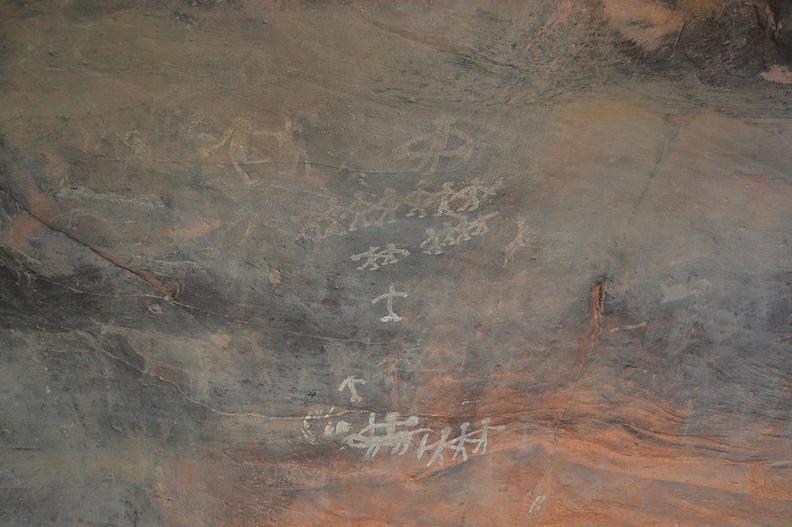
Nandanupadhyay, CC BY-SA 3.0 https://creativecommons.org/licenses/by-sa/3.0, via Wikimedia Commons
Apart from this the illustrations also reveal how people used to hunt during earlier times. Another interesting fact about the Mesolithic time period was that different gears and tools such as bows and arrows, and pointed sticks, were used by hunters which were illustrated in the paintings.
Period 3 – Chalcolithic
Chalcolithic also called “The Copper Age” is the time period when copper was prominently and widely used by humans. The Chalcolithic time period lasted from 4500 B.C. to 3500 B.C.
The Chalcolithic paintings are very similar to the Mesolithic time period as these are focused on revealing the exchange of services and goods between the cave dwellers and the people belonging to the Malwa plains.
Periods 4 & 5 – Early historic
As per many scholars, the time period between the 6th century B.C. to the 4th century B.C. was the early historic period. The paintings from this time period are mostly painted in red, white, and yellow colors.
Here, the paintings have pointed out the religious beliefs of the people who lived here as various figures like magical chariots, trees, etc were found here on the walls. These paintings were considered to be of great significance in Hinduism and Buddhism, and people have tried to build a relationship between the paintings and the religions practiced.
Periods 6 & 7 – Medieval
The Medieval word is derived from Latin meaning “Middle Age,” spanning approximately 500 – 1500 AD. During this time period, black color was prominently used by the cave dwellers as various paintings were made using black color. Further, the black color was made using manganese oxide, red hematite, and charcoal.
Animals were the most common and prominently painted figure found inside the caves. Some examples of painted animals are elephants, barasingha (swamp deer), bison, and deer. This also tells us how animals weren’t domesticated during earlier times.
These paintings also helped us in understanding the lifestyle of prehistoric times. People were usually involved in hunting and used various tools and tactics to hunt wild animals. In one painting, the figure of a wild bovine is painted whereas, in another, some archers were seen gearing up for the hunting activity along with a few horsemen.
However, it is important to understand that not all of the caves were occupied by humans; some were just used for paintings. These caves receive a great amount of sunlight in comparison with others.
Auditorium Cave
Tourists in large numbers visit the auditorium cave every year. It has become a highlight point of this destination. One of the many reasons is the Quartzite towers which are visible from a distance of a few kilometers.
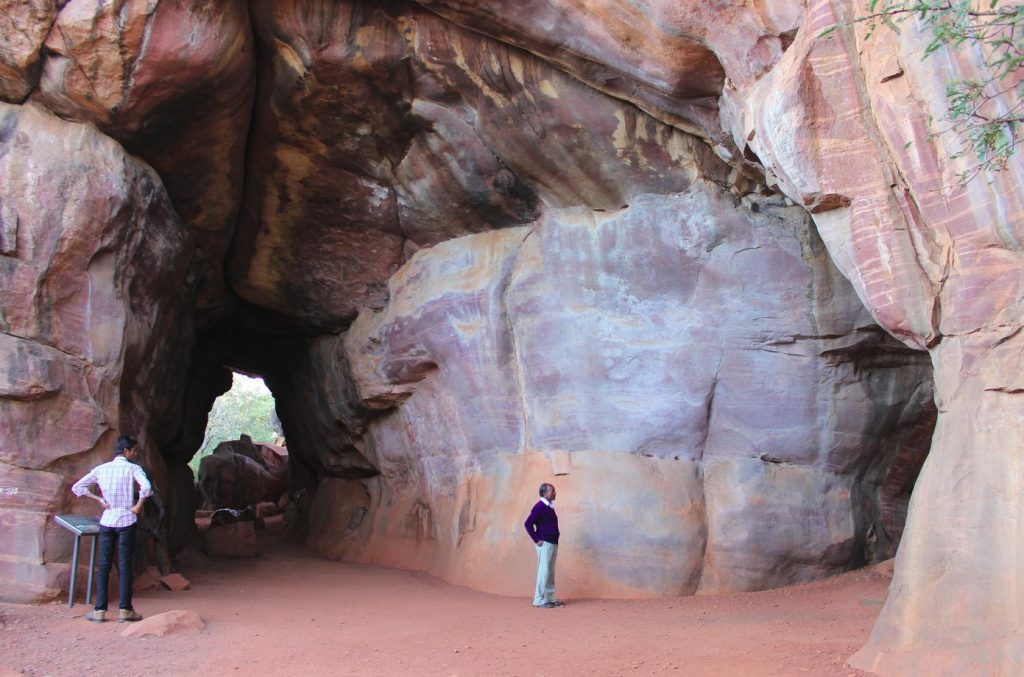
Sanmarga Mitra, CC BY-SA 4.0 https://creativecommons.org/licenses/by-sa/4.0, via Wikimedia Commons
The boulder which is also called “Kings rock,” or “Chief rock,” is believed to be of great importance for the people who lived there. It is a central feature of rock art which was believed to be used for rituals and prayers however there isn’t any evidence recovered that would justify this.
Check out this Video to get a glimpse of the beautiful Bhimbetka Rock Shelters
Tools Used in the Bhimbetka Paintings
Archaeologists believe that the tool used in making this painting was painting brushes of different sizes and shapes, which were made of twigs. These twigs were chewed by the people and then were changed into softer tips so that these can be easily used to give shape and size to the painted figures.
As the site is rich in sedimentary rocks, hence, colors and pigments were obtained from vegetables and these rocks. The evidence also talks about how these colors were used in their liquid forms rather than solid or powdered ones.
Liquid colors were easy to spread over the rocks making the painting job easy for the people. These liquid colors were created by mixing water and oils in the colors obtained.
Bhimbetka reveals the interaction between humans and nature and how the former used the latter to capture the present times. These paintings are the existing proof that humans have always been there on this planet.
The paintings also explain the hunting community and their practices and how they used hunting as a way of living. The rock art and relics recovered are so well-preserved that the colors used are still intact.
Many archaeologists believe that the Bhimbetka rock art was the most advanced work of humans found to date. These rock arts provide immense evidence of the existence of humans during earlier times. This also helped us in understanding the lifestyle of the people and how they survived.
One thing to be noted here is that these paintings also tell us about the religious faith of the people belonging to the ancient time period and how they used to inculcate it in their daily lives.
The Bhimbetka rock art gives us insight into the earliest civilizations and helps us in understanding how people lived in the world we have no means to connect to.
